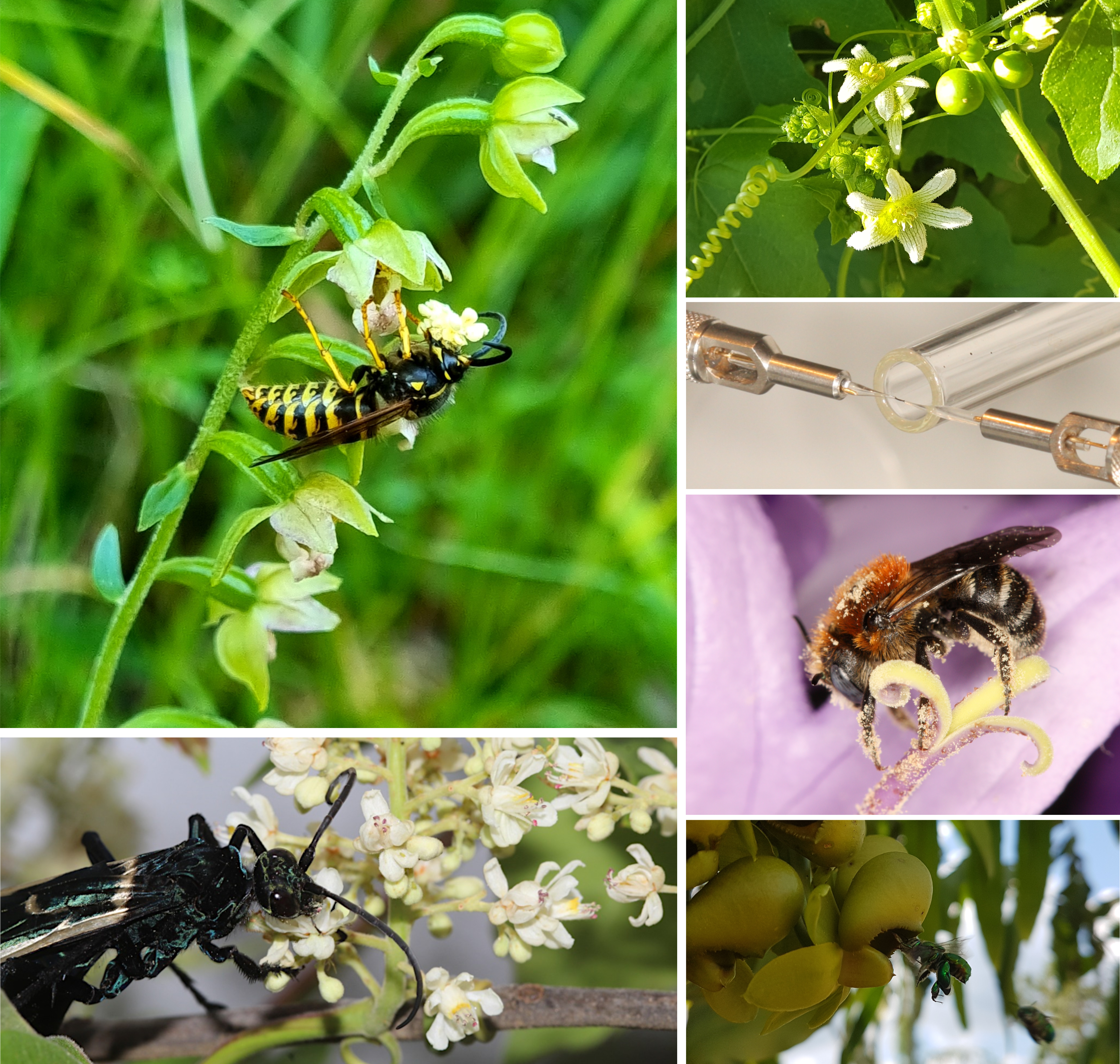Research interests
- Pollination Ecology and Chemical Ecology in Neotropical Orchids
- Floral Scents
- Animal- Plant Interactions
- Electrophysiology in Insect Olfaction
- Evolutionary Ecology
Scientific projects
Main Project
Bee VS. wasp-pollination – Investigating the role of floral traits responsible for the attraction of distinct pollinator groups in two very different systems
In the course of evolution, flowering plants have developed a set of floral traits, including rewards, associated with the attraction of a given group of pollinators. As in many other systems floral scent is considered to be the primary attractant in wasp-pollinated plant species. In addition, visual cues, morphological features, and nectar properties can also play an important role. These cues can even influence evolutionary processes when they are responsible for the attraction of very specific wasp pollinators, thereby representing so-called “isolation barriers” between plant species of a genus. While many pollination syndromes (e.g., bee-pollination) are well investigated, specific floral traits associated with the attraction of wasps as pollinators have been described for a few species only. Thus, the objective of my project is to compare pollinator attracting floral traits that might act as filter mechanisms in congeneric plant species pollinated by bees or predatory wasps in two very different systems.
In the main part I will investigate the specialized pollination system of the European orchid genus Epipactis (Orchidaceae) by comparing 1) distinct floral traits and 2) their possible role as isolation barriers between bee- and wasp-pollinated species, 2) describing species of respective pollinators as well as their antennal and behavioral responses to floral signals and 3) comparing three subspecies of E. helleborine in a molecular genetic approach. The second part of my project is planned during the winter months in Germany and will be performed in NE-Brazil. I will investigate four distinct species of the neotropical genus Serjania (Sapindaceae) that show typical characteristics of wasp-flowers. In contrast to the highly specialized Epipactis pollination system, Serjania flowers are more generalist. Although prey hunting wasps have been reported as main pollinators in some Serjania species, other species are also pollinated by other insects, such as flies, butterflies and bees. So far, it has not been investigated which floral traits do have a key function in pollinator attraction, and which mechanisms determine the range of main pollinators among distinct species. Therefore, my main goal is to 1) characterize the morphology and floral traits responsible for the attraction of wasp pollinators and 2) to determine the respective pollinating wasp species as well as their antennal and behavioral responses to these floral signals.
The comparison between specialized E. helleborine and the generalist Serjania species can not only offer information on the pollination ecology of these two systems, but can also help to describe generally occurring floral traits and differences in plant species that are either pollinated by bees or by predatory wasps, independent of the habitat and the level of specialization. Altogether, my results can offer better insight into wasp-pollination and in the evolution of flowering plants, in general.
Side Projects
- The role of floral scents in pollinator attraction of the Neotropical orchid genus Catasetum
- Antennal sensitivity to spiroacetals in visitors of Campanula flowers
- Bryonia dioica and its oligolectic pollinator Andrena florea
Publications
Milet-Pinheiro P, Pinto CE, Navarro D, Silva JBF, Brandt K, Ayasse M (2023). Floral scent chemistry and pollinators of a sexually dimorphic Neotropical orchid. Plants 12(1): 17. https://doi.org/10.3390/plants12010017
Brandt K, Dötterl S, Ramírez SR, Etl F, Machado IC, Navarro DMAF, Dobler D, Reiser O, Ayasse M, Milet-Pinheiro P (2021). Unraveling the Olfactory Biases of Male Euglossine Bees: Species-Specific Antennal Responses and Their Evolutionary Significance for Perfume Flowers. Frontiers in Ecology and Evolution 9: 727471. https://doi.org/10.3389/fevo.2021.727471
Weithmann S, von Hoermann C, Degasperi G, Brandt K, Steiger S, Ayasse M (2021). Temporal variability of the rove beetle (Coleoptera: Staphylinidae) community on small vertebrate carrion and its potential use for forensic entomology. Forensic Science International 323: 110792. https://doi.org/10.1016/j.forsciint.2021.110792
Brandt K, Machado IC, Navarro DMAF, Dötterl S, Ayasse M, Milet-Pinheiro P (2020). Sexual dimorphism in floral scents of the neotropical orchid Catasetum arietinum and its possible ecological and evolutionary significance. AoB PLANTS 12(4): plaa030. https://doi.org/10.1093/aobpla/plaa030
Steitz I, Brandt K, Biefel F, Minat Ä, Ayasse M (2019). Queen Recognition Signals in Two Primitively Eusocial Halictid Bees: Evolutionary Conservation andd Cast-Specific Perception. Insects 10: 416. https://doi.org/10.3390/insects10120416
Brandt K, Dötterl S, Fuchs R, Navarro DMAF, Sobreira Machado IC, Dobler D, Reiser O, Ayasse M, Milet-Pinheiro P (2019). Subtle chemical variations with strong ecological significance: Stereoselective responses of male Orchid Bees to stereoisomers of carvone epoxide. Journal of Chemical Ecology 45: 464–473. https://doi.org/10.1007/s10886-019-01072-6
Brandt K, Dötterl S, Francke W, Ayasse M, Milet-Pinheiro P (2016). Flower visitors of Campanula: Are oligoleges more sensitive to host-specific floral scents than polyleges? Journal of Chemical Ecology 43: 4-12. https://doi.org/10.1007/s10886-016-0802-z
Contact
Dr. Katharina Brandt
Institute of Evolutionary Ecology and Conservation Genomics
Ulm University
Albert-Einstein-Allee 11
D-89081 Ulm, Germany
Tel. +49 (0)731 50 22665
Fax +49 (0)731 50 22683
Office: M25 4112

